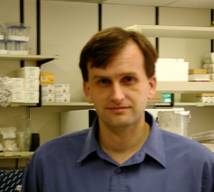|
|
 |
Dr. Hel earned his undergraduate and Master’s degrees in biochemistry, Department of Biochemistry, Charles University, Prague, Czech Republic in 1990. He then earned his Ph.D. in experimental medicine in the Department of Experimental Medicine at McGill University in Montreal, Quebec in 1997. After a post-doctoral fellowship in the Laboratory of Animal Models and Retroviral Vaccines in the National Cancer Institute, NIH, he joined the Department of Pathology at UAB as Assistant Professor in 2003.
Dr. Hel’s laboratory focuses on the development of new HIV-1 vaccine candidates and immunization strategies, the development of new approaches to immune reconstitution therapy for HIV-1-infected individuals, and study of HIV-1-induced pathology in relation to virus-specific immune responses. DNA-based vaccines are a promising approach for vaccination against a variety of pathogens and cancer, because such vaccines are safe, inexpensive, easy to store, and do not cause vector-directed immune responses. Dr. Hel’s group hypothesizes that the immunogenicity of DNA vaccine candidates can be significantly increased by strategies enhancing the activation and recruitment of antigen presenting cells, by modification of the antigen resulting in its improved presentation, by coexpression of costimulatory molecules, and by blocking inhibitory mechanisms. Recent results indicate that vaccine-induced CD4+ T cell responses confer protection against SIV in rhesus macaques in both preventive and therapeutic vaccination protocols. Therefore, Dr. Hel’s group is seeking to identify DNA vaccine strategies that induce persistent, high-level, antigen-specific CD4+ T cell responses. Memory CD8+ T cells that are generated in the absence of help provided by CD4+ T cells are defective in their ability to respond to secondary encounters with the antigen. This represents a major hurdle for immunotherapeutic vaccination against HIV-1-infected individuals. The laboratory also addresses whether the need for a CD4+ T cell help during DNA vaccination can be surmounted by coexpression of costimulatory molecular adjuvants.
Selected Publications
- Hel, Z., Skamene, E. and D. Radzioch. Two distinct regions in the 3′-UTR of tumor necrosis factor-α mRNA form complexes with macrophage proteins. Mol. Cell. Biol. 16:5579-5590, 1996.
- Hel, Z., DiMarco, S. and D. Radzioch. Characterization of the RNA-binding proteins forming complexes with a novel putative regulatory region in the 3′-UTR of TNF-α mRNA. Nuc. Acid Res. 26:2803-2812, 1998.
- Hel, Z., Venzon,D., Poudyal, M., Tsai, W.P., Giuliani, L., Woodward, R., Chougnet, C., Shearer, G., Altman, J., Watkins,D., Bischofberger, N., Abimuku, A., Markham, P., Tattaglia, J. and Franchini, G. 2000. Viremia control following structured treatment interruption and therapeutic immunization of SIV251-infected macaques. Nature Med. 6:1140-6.
- Belyakov, I.M., Hel, Z., Kelsall, B., Kuznetsov, V.A., Ahlers, J.D., Nacsa, J., Watkins, D.I., Allen, T.M., Sette, A., Altman, J., Woodward, R., Markham, P.D., Clements, J.D., Franchini, G., Strober, W. and J. A. Berzofsky. Mucosal AIDS vaccine reduces disease and viral load in gut reservoir and blood after mucosal infection of macaques. Nature Med. 7:1320-6, 2001.
- Hel, Z., Tsai, W.P., Thornton, A., Nacsa, J., Giuliani, L., Tryniszewska, E., Poudyal, M., Venzon, D., Wang, X., Altman, J., Watkins, D.I., Lu, W., von Gegerfelt, A., Felber, B.K., Tartaglia, J., Pavlakis, G.N. and G. Franchini. Potentiation of Simian immunodeficiency virus (SIV)-specific CD4(+) and CD8(+) T cell responses by a DNA-SIV and NYVAC-SIV prime/boost regimen. J. Immunol. 167: 7180-7191, 2001.
- Pal, R., Venzon, D., Letvin, N.L., Santra, S., Montefiori, D.C., Miller, N.R., Tryniszewska, E., Lewis, M.G., VanCott, T.C., Hirsch, V., Woodward, R., Gibson, A., Grace, M., Dobratz, E., Markham, P.D., Hel, Z., Nacsa, J., Klein, M., Tartaglia, J. and G. Franchini. ALVAC-SIV-gag-pol-env-based vaccination and macaque major histocompatibility complex class I (A*01) delay Simian immunodeficiency virus SIVmac-induced immunodeficiency. J. Virol. 76: 292-302, 2002.
- Hel, Z., Johnson, J.M., Tryniszewska, E., Tsai, W.P., Harrod, R., Fullen, J., Tartaglia, J. and G. Franchini. 2002. A novel chimeric Rev, Tat, and Nef (Retanef) antigen as a component of an SIV/HIV vaccine. Vaccine 20:3171-3186.
- Hel, Z. Nacsa, J., Tryniszewska, E., Tsai, W.P., Washington-Parks, R., Montefiori, D.C., Felber, B.K., Pavlakis, G.N., Tartaglia, J. and G. Franchini. Containment of SIV infection in vaccinated macaques: Correlation with the magnitude of virus-specific pre- and post-challenge CD4+ and CD8+ T-cell responses. J. Immunol. 169:4778-4787, 2002.
- Hel, Z., Nacsa, J., Tsai, W.P., Thornton, A., Giuliani, L., Tartaglia, J. and G. Franchini. Equivalent immunogenicity of the highly attenuated poxvirus-based ALVAC-SIV and NYVAC-SIV vaccine candidates in SIVmac251-infected macaques. Virology 304:125-134, 2002.
- Hel, Z., Tryniszewska, E., Johnson, J.M., Harrod, R., Fullen, J., Kalyanaraman, V.S., Altman, J.D., McNally, J., Kaprova, T., Felber, B.K., Tartaglia, J. and G. Franchini. Design and in vivo immunogenicity of a polyvalent vaccine based on SIVmac regulatory genes. DNA Cell. Biol. 21:619-626, 2002.